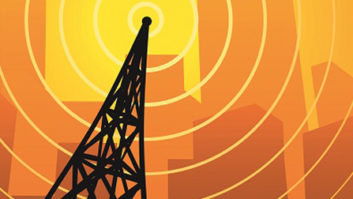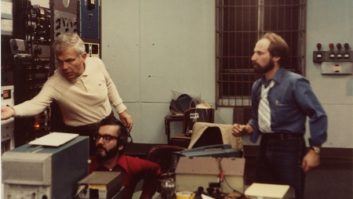Just as the FCC considers IBOC, Ibiquity is underscoring the precedent-setting, proprietary nature of its proposal by deploying its licensing arrangement to broadcasters.
The argument that Ibiquity is a software company and users should pay for software is disingenuous at best. One could apply the same premise to any modern transmitter, audio processor or even an EAS encoder manufacturer today. These are all software-controlled hardware devices.
Broadcasters pay hardware manufacturers when they purchase equipment (perhaps a renewable maintenance fee is also assessed), and they pay their staffs to keep the products running, but they don’t also have to engage a license from the original designer of the products’ software components.
Any such deal is kept between the hardware manufacturer and the software developer. Under Ibiquity’s concept, it would be no less ludicrous for the company to assess a separate license fee to consumers who buy IBOC radios.
Signing your soul
One can only wonder at the reasons behind this move, but clearly they must be relatively dire for Ibiquity to risk the potential negative reactions from broadcasters and regulators at this pivotal time.
Is Ibiquity’s solvency in question without this revenue? Or is it because the broadcast companies who have been footing the development bill are antsy, or they were cautious when Ibiquity was formed and required this future payback/self-sufficiency clause? And will those broadcast companies with ownership interest in Ibiquity be treated any differently than others in this regard?
We can only speculate, but it does provide another reason why putting unilateral control of a broadcast format in the control of a single company isn’t a good idea (e.g., should the company fail, does the format crash along with it?).
To its credit, the FCC hasn’t ever made that mistake before. Let’s hope it doesn’t do so now.
We’re talking about north of $50 million in broadcaster license fees (some estimates place the eventual total at over $100 million), with at least $1.5 million of that coming from public broadcasters – tantamount to a tax increase on all of us. And that doesn’t include the 3 percent levy on gross IBOC datacasting revenues.
The latter is somewhat less onerous, because at least broadcasters only pay if they make money using Ibiquity’s technology. But the ongoing nature of this payment may actually be more galling in the long run to broadcasters, after already having paid up front to license the software and purchase the hardware.
The fine print also hints that updates to the IBOC software may carry additional licensing fees, so a station’s agreement with Ibiquity may involve a long-term liability relationship.
Meanwhile, the NRSC’s AM-IBOC tests have taken longer than planned, and there are reports that not all participants are happy with the results. Specifically, there has been some dissent reported among NRSC members over what interference levels are tolerable in the IBOC-AM system. The latest information indicates that compromise has been reached on the subject. Meanwhile, it appears that the IBOC-AM format will only be recommended for daytime usage. Stay tuned for further information on this developing part of the story.
A rejoinder
I’m devoting the remainder of this column to responding to the remarks of an anonymous but reportedly highly placed source, who took issue with my earlier column on the subject (“FMX+RBDS=IBOC,” March 1).
First, the source disputed my characterization that satellite radio will sound as good or better than IBOC, pointing out that IBOC will run the PAC algorithm at 96 kilobits per second while satellite typically runs 64 kbps for music and 32 kbps for (mono) voice services.
Remember, however, that the PAC algorithm is optimized for very low bit rates, so the difference between 64 and 96 kbps may not be that noticeable to the general listener, particularly in automotive environments.
Further, the satellite services have the advantages of wider-bandwidth transmission channels and spatial transmit diversity, so it is quite likely that their robustness will often be higher for mobile reception. This implies that the IBOC service may be frequently switching to analog in some problematic-coverage or fringe areas, while the satellite service remains stable nationwide. Dynamic (i.e., time-variant) artifacts usually are more annoying than static ones, so this function could wipe out any bit-rate advantage that IBOC might have.
Finally, the analog fallback function of Ibiquity’s system will almost guarantee that broadcasters use the same audio processing on their IBOC service as they do on analog (to avoid sudden level or other audio changes when the analog back-up switches on). This could mean that elimination of occasional multipath distortion will be the only real audio improvement of IBOC.
While that remains a significant benefit, it won’t help FM IBOC gain the perception of sounding superior to satellite radio’s music services (although FM IBOC voice services will likely sound somewhat better than equivalent service on satellite radio). I stand by my original premise that satellite radio will sound as good or better than IBOC, at least for music services.
The real proof will be in listening, of course. No one would be happier than me to return to the day when FM was the better-sounding source in the car – something that hasn’t been the case since the 1970s. But I have my doubts that IBOC will achieve this goal.
More debate
Regarding long tuning times, the source confirms that this problem will remain even after the transition period to an all-digital service (if that ever takes place). A lower-fidelity digital channel will simply replace the FM analog channel for initial tuning and backup, so the problems associated with the long acquisition time, two-tiered audio quality and non-realtime broadcasting will all remain in the post-hybrid IBOC phase.
The source also cites my earlier article as saying that 92 kHz subcarrier services must be shut down. In fact, the column says no such thing, and only suggests that some 92 kHz audio services might suffer interference, and that testing – paid for by Ibiquity – is still underway to satisfy these concerns. Ibiquity is to be credited for providing this funding, but if this wasn’t considered at least a potential problem, why would the company be supporting such tests?
The source feels that mobile data broadcasting will be a key new service provided by IBOC. (Ibiquity is banking on it, too, requiring 3 percent royalty on all datacasting revenues.) Perhaps, but it remains uncertain that service providers will emerge in force to take advantage of this service.
There are certainly other methods of delivering such data today, using already-deployed receivers, and the industry hasn’t exactly caught fire. Broadcasters have heard this song before, and have been disappointed. It’s hard to see what could be different this time, other than the prospects of program-associated data (PAD) used by broadcasters to enhance their main channel audio – which won’t generate any revenue, however. Remember also that the PAD feature was also touted as something RBDS would provide, but never did.
Overall, while mobile broadcast data seems like a great technical offering, from an experienced radio business perspective, it’s hard not to look at it with a jaundiced eye.
On openness
Regarding the closed standard process, I’ll repeat that the bottom line is not how “open” the development process seems, but who ultimately owns and controls the implementation of the spec when it’s deployed. Ibiquity’s controversial licensing regime proves this point.
I would also advise the source to reread the original column. Nowhere does it claim that closed standards “don’t work,” in his words. Obviously, many proprietary formats have served as successful de facto standards throughout the high-tech industry.
No one can deny that these approaches “work,” and do quite well in certain contexts. But a proprietary system of this nature has never been adopted as a de jure U.S. broadcast standard, so a major precedent would be set by doing so in this case. That was my point then, and it remains so now.
Lastly, a question: Why do the defenders of IBOC presented by Radio World (on these pages and online) choose to veil themselves in cloaks of anonymity? Are future reputations being hedged here? Does it belie a lack of real confidence in their own opinions? Just wondering …









